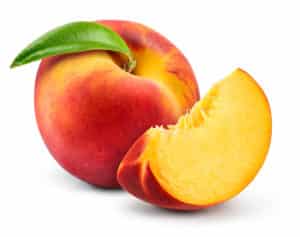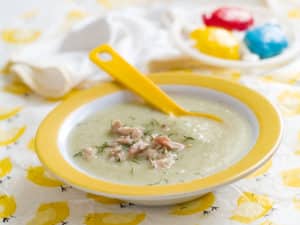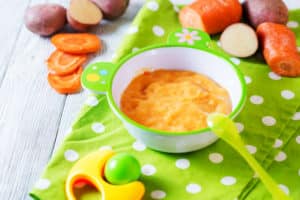Finding the right food for your baby can be quite difficult, especially when he/she is transiting between baby food stages. Most parents struggle to get the right recipe that supplies their children with the right nutrients in the right way.
This article would make your task easier.
In this post, you’d discover six stage 3 homemade baby food recipes. In addition, you’d learn about the importance of homemade Stage 3 purees and all the utensils you need to get this done. Furthermore, you’d find the major differences between stage 3 and stage 4 baby food options.
Table of contents
What is Stage 3 Baby Food?
Stage 3 baby foods are purees that contain small pieces of solid food.

These meals, which are for babies between the ages of 9-12 months, prepare your baby for finger foods. Although your child may have been introduced to solids (in puree form) through his/her stage 2 diet, these foods would supply the solids in thicker consistencies.
At this point, you’re simply giving your little one more solids in chunkier, healthier portions.
Why Homemade Stage 3 Purees?
Why should you go for a homemade puree?
First, you’re assured of quality.
No matter the baby food stage your child is in, you get to provide him/her with what is needed in the right proportion and quality. This way, your child gets all that is needed for healthy living.
Furthermore, homemade purees are freezer-friendly; so you can make them in bulk, store them, and use them when needed.
You also get to determine the texture of the puree based on your child’s current need, preference, and ability to chew.
What Kitchen Utensils Do You Need to Make A Stage 3 Baby Food?
To make any of the stage 3 baby food options in this article, you’d need:
- A food processor or blender
- A cutting board
- Baby food storage containers
- Saucepans
- Steamer pan
- Knives
- Tablespoons
- Cups
Stage 3 Baby Food Recipes
Now that your baby is ready to move to a stage 3 diet, here are six recipes your baby would definitely enjoy:
1. Kale, potato, and tomato puree
What you need:
- 2 handfuls of kale
- 1 Potato
- 1 Tomato
How to prepare:
Boil the kale for 3-5 minutes and allow it to cool down.
After this, peel the potato and cook for about 20 – 30 minutes. Next, you can wash and slice the tomatoes. After slicing, add all the ingredients and mix in a blender till you attain the desired consistency.
2. Chunky peach, raspberry and quinoa puree
What you need:
- 1 cup peach slices
- ½ cup dry quinoa
- ½ cup raspberries
- 1 cup water

How to prepare:
Boil the quinoa in water over high heat. Once it is done, reduce the heat and add the peach slices. Stir together and cover. Let it boil for some extra 5 minutes or until all the quinoa has cooked and the water has evaporated.
After this, you should allow it to cool slightly, then pour everything into a blender and blend. Pulse a number of times until you get a chunky puree.
3. Spinach, sweet potato, and chicken puree
What you need:
- 2 cups of sweet potato
- 2 cups of spinach leaves
- 1 cup of chicken (after removing the bones and skin)
- 2 cups of water
How to prepare:
Steam the sweet potatoes for about 10 minutes until it is soft. Add the spinach and steam for additional 5 minutes until the sweet potatoes are soft enough to be easily mashed.

Next, boil the chicken in another saucepan with salted water until there’s no pink coloration left. After this, you can add the chicken, sweet potatoes, and spinach into a blender and blend them into a chunky puree.
4. Spinach, blueberries, and avocado puree
You’d probably remember this bit from our Stage 1 baby food recipe list.
What you need:
- 2 cups of spinach
- 1 cup of blueberries
- 1 avocado
How to prepare:
Steam the spinach, drain it, and put it in a blender. Wash the blueberries and also put them in the blender. After this, cut the avocado into two vertically.
Next, pull out the avocado pit and scoop out the avocado meat with a spoon. Add the avocado meat to the content in the blender and blend all together until a chunky consistency is attained.

5. Strawberry, sweet potato and farro puree
What you need:
- 2 cups strawberries
- 2 small sweet potatoes
- ½ teaspoon cinnamon
- 1 cup cooked farro
How to prepare:
Steam the peeled sweet potatoes for about 15 minutes. Sprinkle the strawberries with cinnamon and add to the steaming sweet potatoes when the 15 minutes are up, and then steam all for another 3 minutes.
After this, blend the strawberry, sweet potatoes, and cinnamon together until a smooth consistency is achieved. Then mix the puree with the farro.
For a chunky puree, mix the puree and the whole farro together. However, if you want a smoother puree; add the farro and blend too.
6. Minced beef, tomatoes, and leeks puree
What you need:
- 65 grams minced beef
- 1 tomato
- ¼ stalk of leek
How to prepare:
Boil the beef for about 10 minutes.
Then rinse the tomatoes, remove the core, and cut them into pieces. You can either use raw tomatoes or steam them for a few minutes to reduce the acid content. After this, clean the stalk of the leek and chop it into pieces. Then cook the leek for about 5 minutes in a saucepan until it is tender.
Next, add all the ingredients together in a blender or food processor and blend them until a chunky puree is gotten.
A Final Note
As your baby grows into a healthy child, it is best to offer baby food in little quantities first and increase progressively. This is really important because overfeeding can cause diarrhea or constipation in children.
In fact, we recommend speaking to your doctor first before trying out any new baby food option. Once you get the all-important doctor’s approval, we’re confident that the homemade recipes in this article would set your baby up for a healthy childhood.
Enjoy the journey, Mama.
References
Oberlin A. L., Myers K. B., Brinkley J., McKee L. and Wall-Bassett E. (2017). Comparative Nutrient Analysis of Regular, Organic, and Homemade Infant and Toddler Foods. Maternal and Pediatric Nutrition Journal. Accessed on 10th September, 2021 from https://www.google.com/url?sa=t&source=web&rct=j&url=https://www.longdom.org/open-access/comparative-nutrient-analysis-of-regular-organic-and-homemade-infant-and-toddler-foods-2472-1182-1000119.pdf&ved=2ahUKEwjp5YbdovXyAhWIy6QKHZHQDukQFnoECAYQAQ&usg=AOvVaw3DvSTGY8aq7XrRN5HOlncp
Maria Jose Bernal, Sergio Roman, Michelle Klerks, Juan Francisco Haro-Vicente, and Luis Manuel Sanchez-Siles (2021). Are Homemade and Commercial Infant Foods Different? A Nutritional Profile and Food Variety Analysis in Spain. Nutrients. 13(3): 777. Accessed on 2nd August, 2021 from https://www.ncbi.nlm.nih.gov/pmc/articles/PMC7997232/#!po=64.9533
Rufus J. Theophilus, Markus Miller, Wilna H. Oldewage-Theron, and John Dawson (2019). The Winning Weaning Food (WWF): The Development of a Complementary Food for Food-Insecure Infants and Young Children in Malawi. Nutrients. 11(10): 2292. Accessed on 2nd August, 2021 from https://www.ncbi.nlm.nih.gov/pmc/articles/PMC6835519/

